12 Chiefs told by Bonner he’ll appeal death case
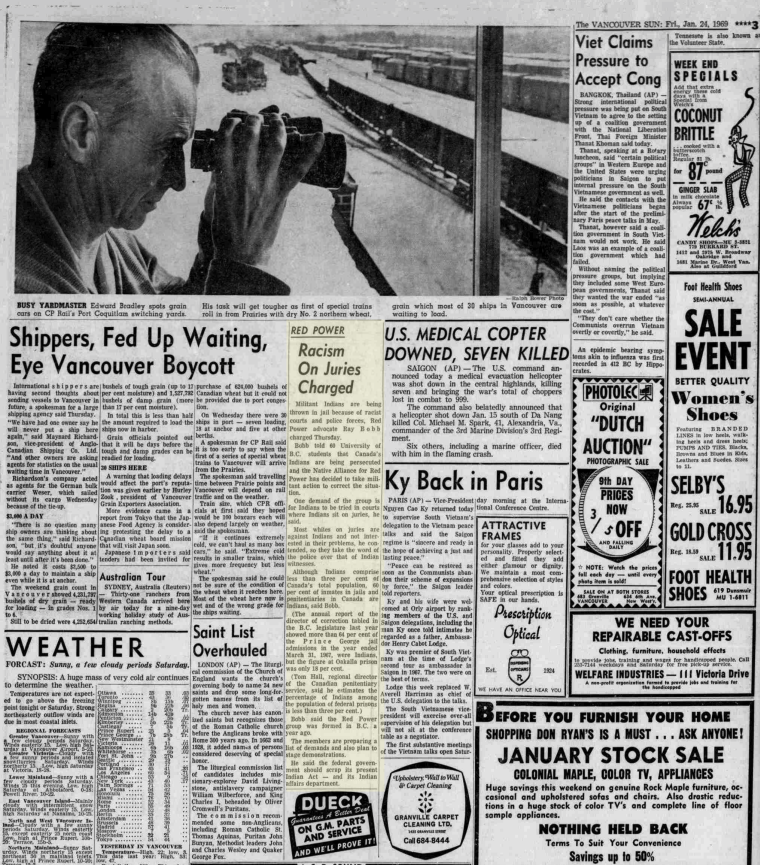
A short article about the murder case of Rose Marie Roper. Focuses on the appeal of the sentence and conviction of the murderers. Includes information on a delegation of Chiefs that called for the appeal. Citation: The Province (October 2nd, 1967). 12 Chiefs told by Bonner he’ll appeal death case. P.10. Found in https://www.proquest.com/hnptheprovince/docview/2379793344/314A90E19E114427PQ/1?sourcetype=Historical%20Newspapers Leave a comment Cancel reply Logged in as Jacquelyn. Edit your profile. Log out? Required fields are marked * Message*
Indians Claim Ft. Lawton

A 12-page spread regarding the Ft. Lawton invasion, including pictures, interviews, and a chronological timeline of events. Citation: Indians Claim Ft. Lawton. (April, 1970). The First Citizen, (no. 6), pp. 1-12. Leave a comment Cancel reply Logged in as Jacquelyn. Edit your profile. Log out? Required fields are marked * Message*
Mercury Poisoning Coming to B.C.?

An article detailing mercury poisoning from a transnational perspective, linking Grassy Narrows First Nations (and Indigenous peoples coast to coast) and Minamata, Japan. The article includes a photo of Tom Keesick, former chief of Grassy Narrows First Nation, during a 1975 delegation to Japan. Citation: Union of B.C. Indian Chiefs. (April, 1976). Nesika (no volume, no issue), p. 9. Leave a comment Cancel reply Logged in as Jacquelyn. Edit your profile. Log out? Required fields are marked * Message*
Lee Maracle
Lee Maracle (1950–2021) was a writer and activist from the Stó꞉lō Nation of the Fraser Valley. She grew up in North Vancouver and became involved in the Red Power movement in the 1970s, which fought for Indigenous rights. She later dictated an autobiography called Bobbi Lee Indian Rebel, where she shared her story as an Indigenous activist. Maracle was inspired by the wave of issues in the 1970s that fuelled her to engage in transnational exchange and activism. During this time, she was part of the first all-Indigenous delegation to China, a trip which was hugely inspiring to her. Maracle also co-hosted North Vietnamese delegates who had come to Canada in the middle of the Vietnam War at the Indo-Chinese Women’s Conference. Image 1. Poster promoting the Indo-Chinese Women’s Conference, which Maracle helped to organise. Maracle went on to write novels, poetry, and non-fiction books. She became one of the most prolific and well-known Indigenous female writers of the 20th century. Her work talked about what it means to be an Indigenous woman, the importance of revitalising Indigenous cultures, and the damage done by colonialism and patriarchy. Maracle’s work does not just show how Indigenous people have survived under colonialism— it also celebrates Indigenous creativity and the hope for a better future.
Red Power
Red Power, a concept that emerged in the 1960s, describes the rise of a shared awareness among the Indigenous peoples of Turtle Island of their unique rights and identities.1 Red Power was a wave of momentum that pushed existing struggles of Indigenous resistance to the forefront. This momentum was created during an era of anti-war protests. Widespread social change was ushered in by young people gathering, especially on college campuses, to protest government war-making in Vietnam.2 Red Power was also inspired by Black Power, a similar concept used to describe movements for Black liberation that arose primarily in the United States as well as the Pacific Islands.3 During the Red Power era of the late 1960s and early 1970s, Indigenous activists used strategies like occupying buildings, organizing mass cross-country protests, and hosting community gatherings to discuss current events. These strategies combined traditional Indigenous leadership with new ways of organizing that were inspired by the Civil Rights Movement in the United States. Red Power helped affirm the agency of Indigenous peoples, where Indigenous peoples have full control over their own lives and nations without external influence. This is important because governments have long tried to control Indigenous peoples by, for example, making it illegal for Indigenous peoples to practice their cultures, speak their languages, and raise their children. However, we must note that Red Power is not just something of the past. The values and mobilizing efforts of Red Power have been passed down through generations of activism and are still alive and well today. Indeed, we stand witness as Indigenous activists from around the world continue pushing back against settler-colonial systems and structures.4 Red Power is usually associated with the United States because many movements there were very influential and gained international attention. However, the spirit of Red Power could not be contained in just one country. For example, in 1973, Arthur Manuel (Secwépemc) organized a twenty-four hour occupation of the Department of Indian affairs (now called Crown-Indigenous Relations and Northern Affairs Canada).5 Over three-hundred and fifty Indigenous youth from various nations participated in the occupation. Image 1. News article about the occupation of Indian Affairs. (September 15, 1973). Kainai News, 5(11). This lesser-known example shows that many Indigenous peoples in Canada were active participants in Red Power mobilizations. While the occupation of Indian Affairs is a powerful moment of Red Power activism in Canada, it is just one example among many. As we explore the exciting world of Red Power and reflect on how the movement may have shaped the world today, we must consider that people have different opinions about the role that Red Power played in organizing Indigenous peoples across Turtle Island. As with all labels, we should be careful when describing certain groups and events as being a part of the Red Power movement. Often, more context is needed to best understand how Indigenous activism has looked at different historical periods. What we may mean when we talk about Red Power is diverse, and there’s a wide array of different strategies and futures to which people are working towards. 1. Turtle Island is a term used by Indigenous peoples to refer to North and Central America.2. For more on youth activism during the Vietnam War era, visit an interactive website created by the University of Washington’s Antiwar and Radical History Project.3. The movement was founded in 1966 by Bobby Seale and Huey Newton, who met at Merritt College in Oakland, California. However the movement had a global reach including offshoots created in Australia (the Black Panther Party) and Bermuda (The Black Beret Cadre).4. These systems use violence to divide Indigenous nations, limit Indigenous autonomy, and take over Indigenous lands and resources.5. Arthur Manuel was a prolific political leader for the Secwépemc Nation. His father, George Manuel, served as president of the National Indian Brotherhood and the World Council of Indigenous Peoples.
Charges denied
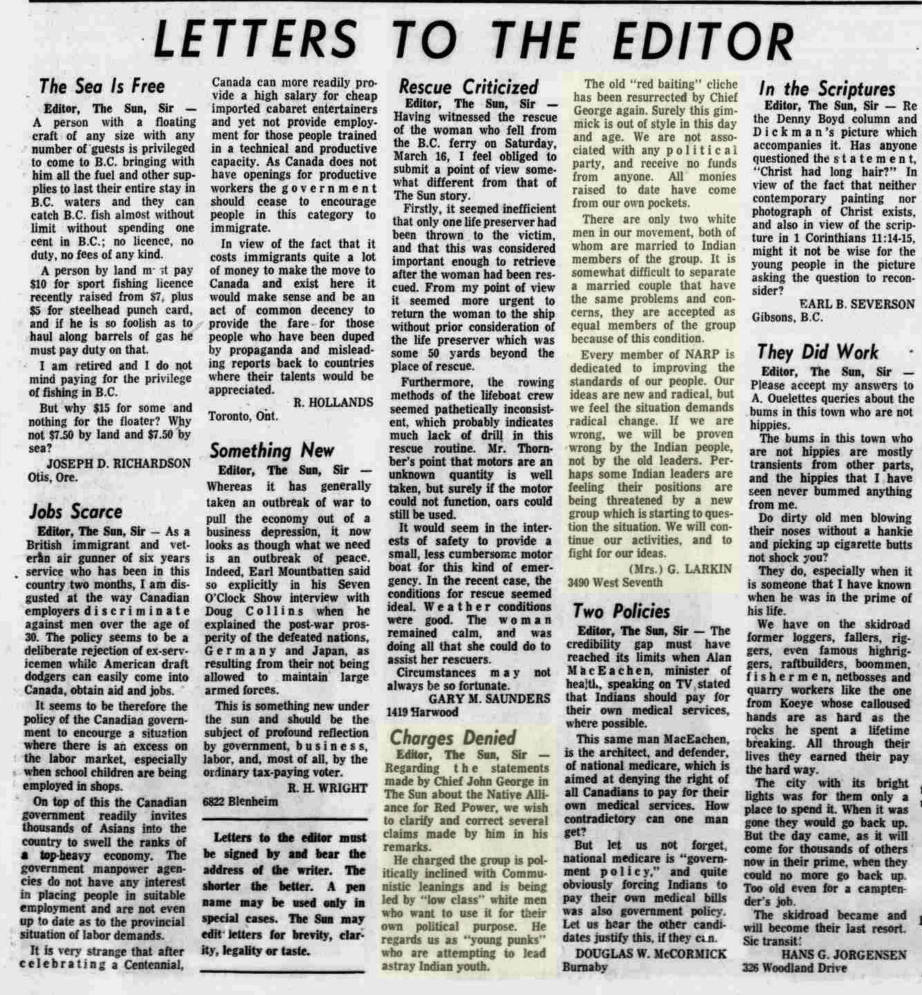
In this letter, Gerry Larkin responds to critiques of NARP by Chief John George. She clarifies the purpose of NARP and asserts the importance of political change that questions the legitimacy of ‘old leaders’. Citation: Vancouver Sun (April 2, 1968). Charges denied. Pg 5. Found in https://www.proquest.com/hnpvancouversun/docview/2240399412/3233CCFFFEB84FC6PQ/128?accountid=13800&sourcetype=Historical%20Newspapers Leave a comment Cancel reply Logged in as Jacquelyn. Edit your profile. Log out? Required fields are marked * Message*
Indian official decries Red Power movement
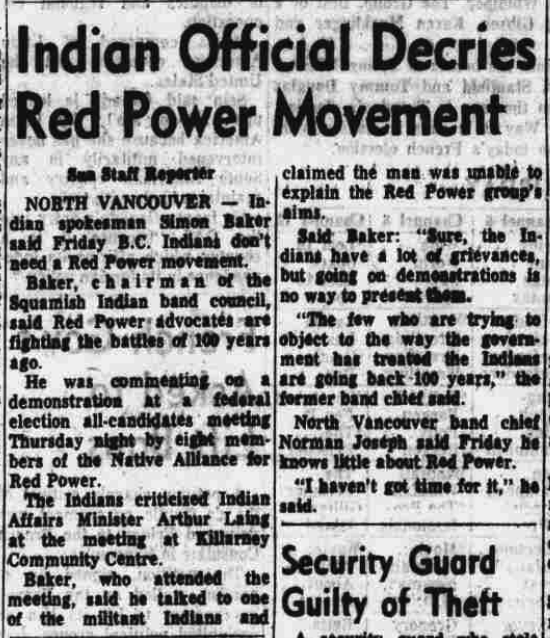
This article provides a critique of the Native Alliance for Red Power (NARP). It quotes Smin Baker, Chairman of the Squamish Band. Additionally, it provides details about a demonstration where eight NARP members protested the Federal all-candidates meeting. Citation: Vancouver Sun (June 22, 1968). Indian official decries Red Power movement. Pg 67. Vancouver, BC, Canada. Found in https://www.proquest.com/hnpvancouversun/docview/2240392902/E204839505D45D0PQ/54?accountid=13800&sourcetype=Historical%20Newspapers Leave a comment Cancel reply Logged in as Jacquelyn. Edit your profile. Log out? Required fields are marked * Message*
Crisis and resolution for B.C Indians
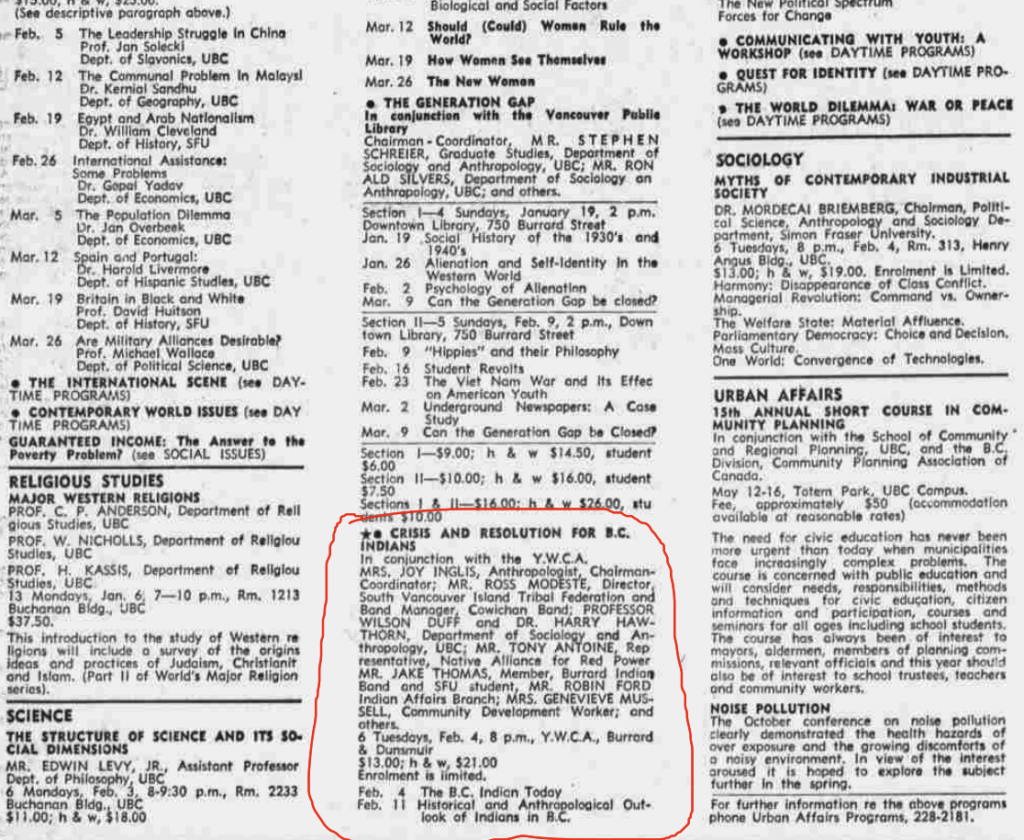
This ad promotes a series of talks titled ‘Crisis and Resolution for BC Indians’. Tony Antoine organized and spoke at the event as a representative of the Native Alliance for Red Power. Citation: Vancouver Sun (January 4, 1969). Crisis and resolution for B.C Indians. Pg 11. Vancouver, BC, Canada. Found in https://www.proquest.com/hnpvancouversun/docview/2240355845/E204839505D45D0PQ/48?accountid=13800&sourcetype=Historical%20Newspapers Leave a comment Cancel reply Logged in as Jacquelyn. Edit your profile. Log out? Required fields are marked * Message*
Band Chief slams ‘Red Power’ group
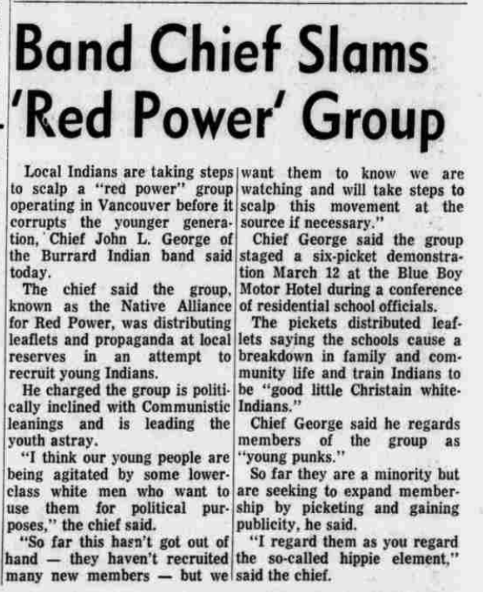
This article is a critique of a protest hosted by the Native Alliance for Red Power at a meeting for residential school officials. Includes critiques from Chief John L. George of the Tsleil-Waututh Nation. Citation: Vancouver Sun (March 21, 1968). Band Chief slams ‘Red Power’ group. Pg 37. Vancouver, BC, Canada. Found in https://www.proquest.com/hnpvancouversun/docview/2240377199/E204839505D45D0PQ/45?accountid=13800&sourcetype=Historical%20Newspapers Leave a comment Cancel reply Logged in as Jacquelyn. Edit your profile. Log out? Required fields are marked * Message*
Indians condem ‘Red Power’ group

This article outlines criticism of a protest held by the Native Alliance for Red Power against a meeting of residential school officials It includes criticisms from Chief Dan George of the Tsleil-Waututh Nation and Chief Albert Douglas of the Cheam Nation. Citation: Vancouver Sun (March 20, 1968). Indians condem ‘Red Power’ group. Pg 37. Vancouver, BC, Canada. Found in https://www.proquest.com/hnpvancouversun/docview/2240790453/E204839505D45D0PQ/44?accountid=13800&sourcetype=Historical%20Newspapers Leave a comment Cancel reply Logged in as Jacquelyn. Edit your profile. Log out? Required fields are marked * Message*
